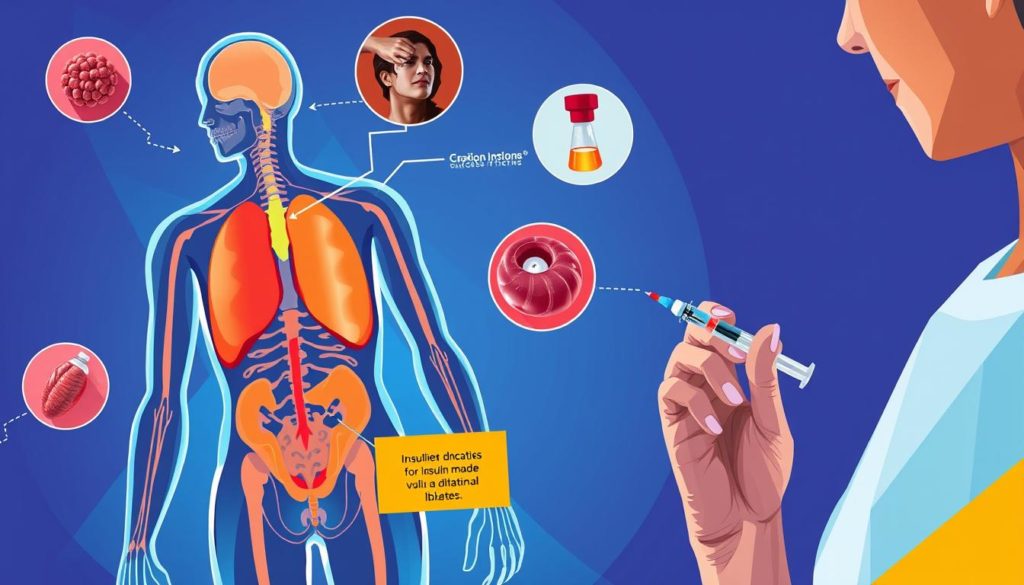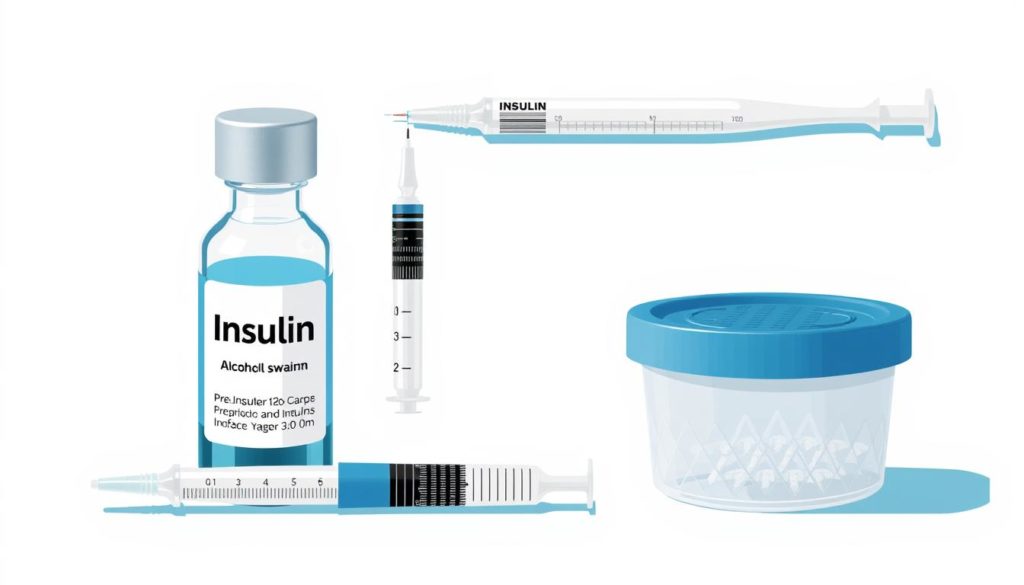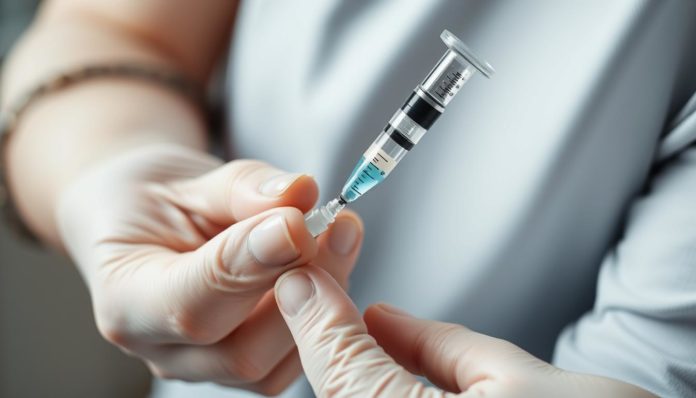Did you know that proper insulin injection can prevent up to 80% of complications in diabetes management? Getting the right insulin injection technique not only ensures good glucose control. It also boosts your overall well-being.
Learning to give an insulin shot correctly is more than just a poke. This step-by-step insulin injection guide will equip you with the necessary skills and confidence to effectively manage your diabetes.
Choosing the right syringes and the best injection site is key. Following these guidelines will make the process smooth and almost painless.
Injecting insulin might seem scary at first. But with this insulin shot tutorial, you’ll quickly become an expert. Healthcare providers stress the use of consistent brands and types of supplies to avoid mistakes. They highly recommend recording the instructions and practicing frequently for the best outcome.
Understanding Insulin and Its Importance
Insulin is essential for keeping blood sugar levels in check. It’s central to good diabetes management. Knowing how insulin works in the body is crucial.
What Is Insulin?
Produced by the pancreas, insulin regulates blood sugar. It helps cells absorb glucose from the blood for energy. For diabetics, managing insulin intake is key to balance.
Why Is Insulin Injection Necessary?
People with diabetes, especially Type 1, need insulin shots. Their bodies can’t make or properly use insulin. These injections keep blood sugar levels steady.
Types of Insulin
It’s important to know the different insulin types for diabetes management. They vary by how long they work and how quickly they start.
- Rapid-acting
- Short-acting
- Intermediate-acting
- Long-acting
Choosing the right insulin and timing doses is vital. This strategy improves blood sugar control and health.

Gathering Supplies for Insulin Injection
Getting ready for an insulin shot means gathering all needed supplies first. This step makes sure the injection process is both safe and efficient. It helps avoid mistakes and health issues.
Insulin Vials and Syringes
Insulin is sold in different strengths such as U-100, U-300, and U-500. You must pick a syringe that fits the insulin strength to dose correctly. Using the wrong syringe can be harmful.
Alcohol Swabs and Sharps Containers
You need alcohol swabs to clean the skin before the shot. This lowers the infection risk. Also, a sharps container is important for safely throwing away used needles. It keeps everyone safe from needle injuries.

Preparation Tips
Important tips include checking the insulin’s expiration date. Also, make sure it’s at room temperature before using. These steps prevent pain during the shot and make sure the insulin works right. Together, they make insulin shots safer and easier.
Preparing the Insulin Injection Site
Getting ready for an insulin shot needs careful site choice and prep. This makes sure the insulin works well and hurts less. You can pick from several spots like the belly, upper arms, upper butt, or the thighs. Each place offers different benefits and changes how fast insulin gets into your body.
Choosing an Injection Site
It’s key to pick the right place for your shot. The belly is often preferred because it absorbs insulin evenly. Other good spots include the upper arms, though they take in insulin a bit slower, and the thighs and butt, which are the slowest. Changing where you inject is important to prevent skin problems that can mess with insulin absorption.
Cleaning the Injection Site
Cleaning the spot properly lowers the chance of infection and irritation. If the area is dirty, just wash it with soap and water. If it looks clean, a quick swipe with an alcohol swab can kill germs. But don’t overdo it, as too much alcohol can dry out and irritate your skin. Keeping the site clean helps the insulin work better, which means easier blood sugar control.
How to Give an Insulin Shot
Giving an insulin shot is easy if you know the right steps. Here’s a guide to show you how. This guide uses insulin injection best practices.
Filling the Syringe with Insulin
Start by getting the correct insulin dose ready. Keep the insulin bottle steady and put the syringe in without letting air inside. Pull the plunger back to fill it with insulin.
If you see air bubbles, tap the syringe lightly. This will move the bubbles to the top. Then, push them out.
Mixing Insulin Types
Not all insulin types should be mixed. Don’t mix clear insulins. You can mix cloudy insulins like N or NPH if needed. To do this, roll the insulin vial gently in your hands.
Make sure everything is mixed well before pulling it into the syringe.
Injecting the Insulin
For the injection, follow these insulin injection best practices. Grab a skin fold at the injection spot. Put the needle in at a 45 to 90-degree angle. This depends on what device you use and what feels right for you.
Stick to these steps for a safe injection. Knowing how to give an insulin shot is key to managing diabetes well.
| Step | Description |
|---|---|
| Fill Syringe | Draw the correct dose, eliminate air bubbles |
| Mix Insulin | Roll cloudy insulin vials, keep clear insulin separate |
| Injecting | Pinch skin, inject at the right angle |
Techniques for Minimizing Discomfort
Getting an insulin shot can feel scary. Yet, with the correct approaches, you can make it comfortable. These simple steps make the process smoother and hurt less.
Pinching the Skin
A good way to minimize insulin injection pain is by lightly pinching the skin where you’ll inject. This makes a firmer surface, so the needle goes in easily. It won’t hurt as much.
Also, changing the injection spots helps avoid scar tissue. This keeps injections comfortable.
Injecting at the Right Angle
The angle of injection is key to less pain. Use a 45º or 90º angle, based on your body’s fat layer. Injecting slowly and without haste lowers pain too.
Don’t rub the spot after injecting. This helps avoid more discomfort.
Rotating Injection Sites
It’s important to rotate your insulin injection sites. This prevents preventing lipohypertrophy — hard, fatty tissue that affects how insulin is absorbed.
Importance of Rotation
Using different spots for injections helps avoid scar tissue build-up. This makes sure the insulin works as it should. The main spots include your abdomen, thighs, buttocks, and upper arms.
Always choose areas without bruises, swelling, or tenderness for injections.
Keeping an Injection Site Record
Keeping track of your insulin injection site rotation is key. By marking down each spot, you ensure a balanced rotation. This method prevents preventing lipohypertrophy and boosts diabetes management.
| Site | Characteristics | Best Practices |
|---|---|---|
| Abdomen | Most common site | Avoid area 2 inches around the navel |
| Thighs | Easy to reach | Use upper outer part |
| Buttocks | Less used | Inject into upper outer quadrant |
| Upper Arms | Convenient for some | Inject into fatty tissue at the back of the arms |
Dealing with Injection Complications
For many people with diabetes, taking insulin shots is an everyday thing. But sometimes, problems with insulin shots can happen, causing discomfort and other issues. It’s very important to fix these problems to stay healthy and keep the treatment working well.
Common Issues and Solutions
Insulin shots can lead to several common problems. These include pain where you get the shot, insulin leaking, or skin reactions. Here are some suggestions to help deal with these problems:
- Pain: Make sure you’re injecting at the correct angle and pinching the skin the right way. Changing where you inject and using fresh needles can reduce pain.
- Leakage: If insulin leaks at the injection site, check the needle’s position before injecting. Holding the needle in place for a bit after the injection can help stop leaks.
- Skin Reactions: If you notice redness or swelling, try rotating your injection spots, keeping the area clean, and using antiseptic swabs before injecting.
Dealing with these issues the right way can make insulin shots easier, keeping you healthy and comfortable.
When to Contact a Healthcare Provider
If problems with insulin shots don’t go away or get worse, it’s time to see your healthcare provider. Don’t ignore things like a lot of pain, ongoing leaks, infections, or strange reactions on your skin. Getting help early from a professional can stop bigger problems and make sure you’re dealing with insulin shots the right way.
Storing Insulin Properly
Storing insulin right is key for keeping its strength and making sure it helps manage diabetes well. If you’re using insulin now or keeping it for later, you need to store it correctly. This helps control your blood sugar levels well.
Temperature Guidelines
Insulin needs to be kept at certain temperatures to work right. Store unused insulin in the fridge at 36°F to 46°F (2°C to 8°C). Insulin you are using can stay at room temperature. Just keep it away from direct sunlight and heat. Remember, freezing insulin ruins it and makes it not work.
Expiry Dates and Usage
Watching the expiry dates of insulin is also crucial. Using insulin past its expiry can result in bad blood sugar levels. Always check the date before use and throw away any that’s expired or looks damaged. This ensures the insulin you use will truly help manage your diabetes.
FAQ
What is insulin?
Insulin is a vital hormone for managing glucose. It plays a key role in controlling blood sugar levels. This is especially important for people with diabetes to keep their glucose in check.
Why is insulin injection necessary?
Individuals with diabetes need insulin injections to help manage their sugar levels. Their bodies struggle to produce enough insulin or to use it correctly.
What are the types of insulin?
Insulin is available in several forms, each with different acting times. There’s rapid-acting, short-acting, intermediate-acting, and long-acting insulin. These cater to various treatment needs.
What supplies do I need for an insulin injection?
You’ll need insulin vials, syringes, alcohol swabs, and a container for needles. Ensure your syringe matches your insulin’s concentration (e.g., U-100, U-300, U-500).
How should I clean the injection site?
Use soap and water for cleaning if the site is dirty. Otherwise, an alcohol swab works. Don’t use alcohol on clean skin to avoid irritation.
What is the best technique to fill a syringe with insulin?
Check the dose and remove air bubbles. Know if your insulins can mix. Roll cloudy insulins like NPH to mix them evenly.
How can I minimize discomfort during injections?
Lightly pinch the skin to firm it up. Choose the right injection angle, between 45º or 90º. Inject slowly and don’t rub the injection site afterward.
Why is rotating injection sites important?
Changing injection sites avoids lipohypertrophy, which affects insulin absorption. Keep track of your sites to ensure effective insulin use.
What should I do if I experience injection complications?
Adjust the injection site or angle if you have pain or leakage. Contact a healthcare professional if problems continue or an infection appears.
How should I store insulin properly?
Keep insulin in use at room temp away from sun and heat. Store unused insulin in the fridge but not in the freezer. Always check the expiry date for safety.


